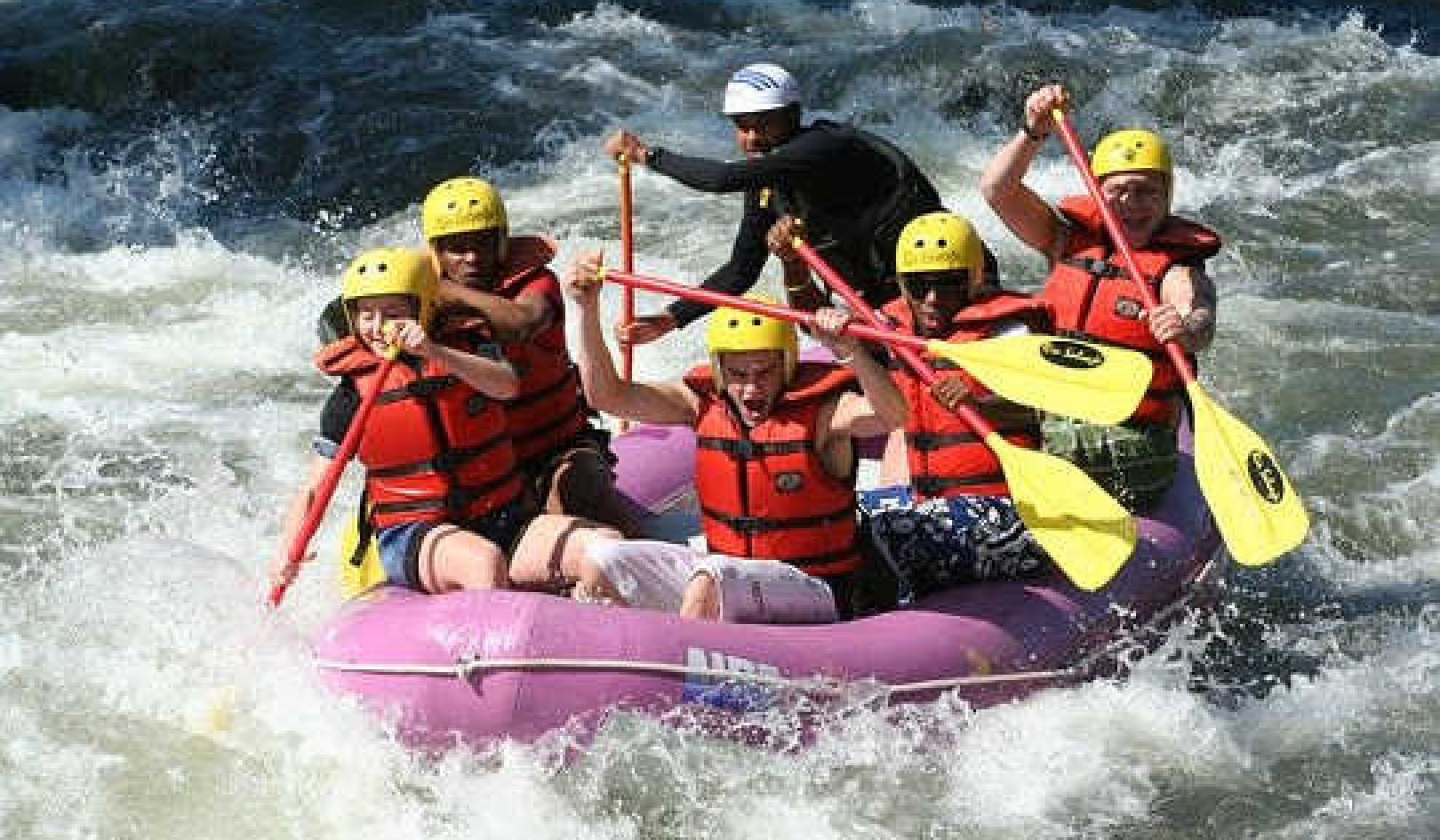
Image by 3D Animation Production Company
Most people think that your worst fear when rowing on the ocean is a storm. Sure, when the waves get bigger than your house, it can be a little unsettling. But that also means you’re going fast, very fast.
The worst thing that can happen isn’t a storm; it’s being on the wrong side of one. Even without a sail, wind is everything out on the ocean. When it’s blowing, the water’s moving, and so are you. But when it stops, you may as well be rowing your way through hair gel.
With 500 miles to go, we have been on the ocean for 28 days. We are 185 miles ahead of R4J and 24 hours ahead of the world record. But then the wind stops, and so do we.
A storm has appeared on the weather report, a storm that has no logical reason to be there. But I shouldn’t have been surprised; the only thing the Atlantic is consistent at is inconsistency.
At this point we are already rowing what’s called “three up.” This means that three people are on the oars at all times while only one rests. This means everyone gets more rowing time and less sleeping time. We have to be prepared.
The effects of the impending storm will be twofold.
First, while we approach it, we have no wind. The weather is against us, meaning any progress will be difficult. With no wind to help offset the currents, we’ll be lucky if we manage to just stay still.
Second, when we do finally hit the storm, we will have wind, lots of wind. But not the wind we want. This wind will come at us from all sides, forcing us to deactivate the autotiller and steer manually. Once again, the odds of making any meaningful progress are basically zero.
This news is devastating. According to the projections, this storm will shrink our lead on R4J to a razor-thin margin. And it effectively wipes out our chances of achieving the world record. That goal has become impossible.
So I find myself crammed into the American Spirit’s claustrophobic cabin, rubbing the salt and shredded skin off my forehead and trying to will a plan into place. But nothing comes.
There is no “solution” to this problem, and problems without solutions are the ones that truly test the mettle of high-performance teams. The only way to achieve the goal we are all leveraged toward achieving is to do something nobody has ever done before. Right there, in the middle of the raging ocean, Latitude 35 will have to do the impossible.
Striving for the Impossible
The storm has destroyed our pace. By the time we’ve fought our way through on manual steering, our speed has gone from 3.0 knots to 0.8 knots. It is worse than we thought it was going to be, and my team needs a plan.
Crunched into that cabin, I push away the maps, turn away from the GPS, and take out my notebook. I close my eyes and let myself start to think.
I’m not sure how long I spend in there. I’m guessing at least a good hour or two. By the time I open the door to face my anxious team, my brain has done its job; the problem has been solved. I have a plan, and it is absolutely insane.
We have 400 miles left to go—400 miles exactly. We have five days left to beat the world record. Even a rower can do math like that. The answer is clear. In order to hit our goal, we will have to row 80 miles every day for the next five days.
The fact that most readers don’t gasp at that means that I should probably explain. What I just said does not happen. Some would even say that it cannot happen.
A great day in the Talisker is 70 miles. Any team averaging that would break the world record. It’s a fantastic pace that requires an elite crew pulling at 100 percent for 100 percent of the time.
A 75-mile day is extraordinary. Maybe your big engine guys had an extra helping of freeze-dried pierogis that morning. Maybe a friendly whale gave you a little shove. It’s cause for celebration. Eighty-mile days are almost unheard of. They require a powerful storm to push the boat at a pace outside of expected human limitations. You might get one in a race this long. We need five, and there are no more storms in sight.
This is it. This is my plan. The only way forward is the way forward. Our goal has been locked inside a vault. The only way in is to tear the door off the hinges. That’s not something a person is supposed to be able to do, but there is only one way to find out.
I have reached the greatest test of my career as a leader. This will be the defining moment of my life’s work. The way my team reacts will confirm whether or not quitting like a winner, learning how to rest, making bad decisions in a good way, motivating individually, answering the question why? and leveraging human emotion works.
I have been trying so hard to become a good leader that I never realized the biggest truth of leadership. You have to make good decisions. You have to put in the time. You have to care. But, ultimately, your success isn’t up to you. It never was. It’s up to them.
Putting The Team to the Test
This is the test that will truly measure whether or not we are a high-performance team. The test is not whether we can or cannot row 80-mile days. The test is whether or not my team will even try.
Matt is the first to respond. “Thank God,” he says. “I thought you were going to say something like 100 miles a day.” He looks around at the others. “You guys don’t actually think this is out of reach do you?”
“Not at all, mate,” Alex responds. “I’ll do whatever you need me to do, skip. I’ll row all night if I have to.”
Now it is Angus’s turn. A silence takes over the boat as we wait to hear his opinion. Three out of four will not cut it. If Angus is out, we all are. “When Jason and I agreed to team up for this year’s race,” he says at last. “It was with the assumption that we had a better chance at history together than we did apart.”
He takes another pause. “I’ll be honest when I tell you that I wasn’t sure how well we’d work together. But now . . . we’re brothers.” I nod my head in agreement. Angus turns back toward Matt and Alex. “And so are we.” They nod also.
“We aren’t the same guys who went into this. We’re different. Jay gave us that.” He looks me dead in the eyes. “You gave this to all of us. All we asked for was a chance at history. Well, boys, here it is: five days to row 400 miles. It’s not a very good chance, but it’s our chance. And I personally wouldn’t want to be taking it with any other team.”
This moment, hearing these words from my team, is the pinnacle of my athletic career. It is better than any finish line I have ever crossed. This team—a team that I built in the hopes of finally becoming the type of leader I always dreamed I could be—has just shattered the only expectation that really matters: mine. After that moment, I can never be the same.
LEADERSHIP LESSON: BE CHANGED
When you do what we did out there on the water, you are giving yourself wholeheartedly to a goal you believe with all your might is worthy of yourself. When you do that, when you surrender yourself completely to the process, it changes you. It always changes you.
Accomplishing that goal requires you to thoroughly leverage the emotions of your team, but it also means that they will leverage yours as well. When you get to a moment like I did, and you will, and this team that you now genuinely love succeeds in the exact moment you need them to, you will not walk away from that moment the same way you entered it.
Some people aren’t interested in that. They don’t really want to be changed by their goals or their teams. And, to be honest, there’s nothing objectively wrong with that. You can have a perfectly fine career being an individual contributor to a company. Seriously.
You can punch the clock and have a terrific life. But you will not reap the rewards of being on a high-performance team or of leading one. If you want those things, you have to give yourself to something greater than yourself. You have to be vulnerable.
Doing strong thing means showing a lot of weakness. But the reason I, and others like me, do what we do is because there is an intense reward that comes from identifying an object you think might be too heavy for you to move, setting your shoulder against it, and pushing as hard as you can.
Because if you are actually able to move that massive weight, you’ll never doubt your own strength in the same way again. Ever.
Self-confidence does not exist in a vacuum. It has to be earned, and the best way to earn it is to attempt something you didn’t think you’d be able to do. This is true for teams as well, but at an even larger scale. Big goals can bring self-confidence, but impossible goals require a team.
Achieving those brings you something beyond confidence. It’s a form of transcendence that shows you not only how powerful you can be as a single person but how powerful we can all be as people who work together. That’s the real goal of high-performance leadership.
It’s not just about hitting that sales number or winning that race. It’s about you and your teammates discovering together what can happen when emotional human beings connect and commit to a goal. Once you see that, you’ll be changed.
You’ll never again hear a story like mine and say, “I could never do something like that.” You’ll say, “I am going to do something even greater.”
Every step of the high-performance process in this book is designed to help you move those immovable objects with your team. But, fair warning, once you do that, you won’t be the same person you were before. And neither will your teammates.
Together, each of you will have become someone exceptional. Someone powerful. Someone with true, earned confidence. Someone impossible.
Row, Row, Row Your Boat
The first day after we realized our predicament we rowed 79 miles. The next day we did 94 miles. Then 91 miles.
With just 48 hours until the expiration of the chance for a world record, we have only 136 miles to go. The team is driving the American Spirit’s jaws around the jugular of the Atlantic Ocean. And, for the first time, the unbeatable ocean suddenly feels mortal. But so are we.
With 48 hours left, we have little left in the tank. We are sleeping for only 40 minutes or less and then rowing for a minimum of two hours. Matt especially has kicked into high gear. He routinely ends his shift only to strap back in for another one. But our efforts are taking a toll.
All of us are hallucinating. At one point Angus taps me on the shoulder to warn about the old lady running around the boat trying to smack us with an oar. I am having visions as well, but mine are a little more serious.
I see people: the people who have mentored me, coached me, and molded me over the years into the exhausted but powerful leader I have become. I see Mark and Michiel, I see my dad, I see Don Wiper and my sponsors. I talk to them, and they talk to me. I can never remember their responses, but I always remember their lessons.
As the sun goes down on January 17, I come off my shift, switching with Angus in a quick 15-second interchange that he and I have performed more than 200 times now.
I heave myself into the cabin to figure out where we stand. I know we have been weak that day. There is no way we’ve been keeping up with our 90-mile pace of the past few days. I’ll be surprised if we’ve hit even 70 miles. For a moment I feel that we have been defeated, but then I check the map. I start crying.
Eighty-eight miles. We have gone 88 miles on our “weakest” day so far. That means we have to cover only 48 miles in the final 24 hours. We are ahead of Row4James. We are hours ahead of the world record. We are going to do the impossible.
In the late afternoon of January 18, 2017, Latitude 35 crossed the coordinates of 17 degrees north, 61 degrees west, which marks the official finish line of the Talisker Whisky Atlantic Challenge. It took us 35 days, 14 hours, and 3 minutes to cross it, breaking a 13-year-old world record by a shockingly close 11 hours. My team has achieved our something greater. Together, Latitude 35 has made history. Now it’s your turn.
GATHERING POINT: BECOME IMPOSSIBLE
Plan to change: If you choose to give all of yourself to a certain endeavor, you should expect to be changed by it forever. This is the consequence of being part of a high-performance team. As a leader, this is ultimately the trade-off you must be comfortable with for yourself, and for others.
Mercenaries: Those who say no to being part of a high-performance team can still be great individual contributors to a larger organization. There is nothing wrong with that, and every organization needs those people as well. But they are not the people whom high-performance teams are made of.
The high-performance leader: As a leader, you help others achieve their goals by building trust and acting authentically and selflessly toward them. When the moment comes that separates good teams from high-performance teams, you will have to look them in the eye and ask for nothing less than everything they have. If you practice what you’ve learned in this book, they will look straight back at you, and give it.
©2019 by Jason Caldwell. All Rights Reserved.
Excerpted with permission from Navigating the Impossible.
Publisher: Berrett-Koehler Publishers. https://bkconnection.com/
Article Source
Navigating the Impossible: Build Extraordinary Teams and Shatter Expectations
by Jason Caldwell World-record endurance athlete and professional leadership coach Jason Caldwell draws on his amazing experiences to show how anyone can build and lead teams that accomplish incredible things. This book is a distillation of Jason's worldwide speaking programs delivered to packed crowds at Fortune 500 companies and universities worldwide. It is the answer to a question he is constantly asked: How were you and your teams able to accomplish such seemingly impossible goals? And it's also a guidebook that can teach anyone how to do the same. (Also available as a Kindle edition and as an Audio CD.)
World-record endurance athlete and professional leadership coach Jason Caldwell draws on his amazing experiences to show how anyone can build and lead teams that accomplish incredible things. This book is a distillation of Jason's worldwide speaking programs delivered to packed crowds at Fortune 500 companies and universities worldwide. It is the answer to a question he is constantly asked: How were you and your teams able to accomplish such seemingly impossible goals? And it's also a guidebook that can teach anyone how to do the same. (Also available as a Kindle edition and as an Audio CD.)
Another Book by this Author: WHAT IF
About the Author
 Jason Caldwell is the founder of Latitude 35, a leadership training firm that operates around the world. He is also an adventure racer who currently holds over a dozen world records across five continents. He has worked with companies such as Nike, Booking.com, and Santander Bank and has offered programs at institutions of higher education including Columbia Business School, the Wharton School, and the Haas School of Business at the University of California, Berkeley.
Jason Caldwell is the founder of Latitude 35, a leadership training firm that operates around the world. He is also an adventure racer who currently holds over a dozen world records across five continents. He has worked with companies such as Nike, Booking.com, and Santander Bank and has offered programs at institutions of higher education including Columbia Business School, the Wharton School, and the Haas School of Business at the University of California, Berkeley.
























